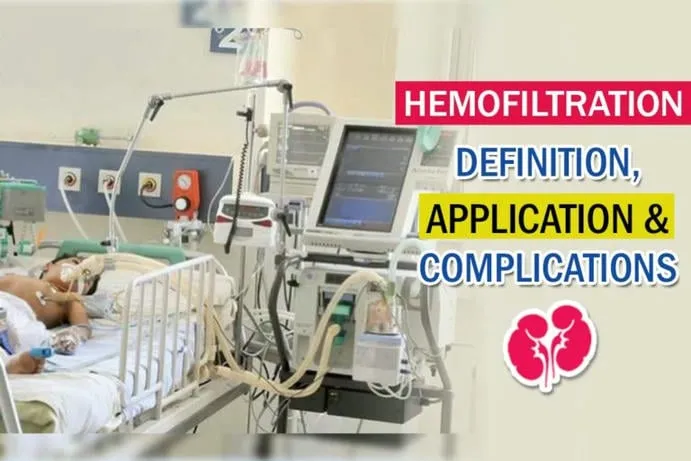
Hemofiltration is a term not often heard outside of medical circles, but it plays a crucial role in treating patients with kidney failure or severe fluid overload. Imagine it as a kidney dialysis but with a twist. If your body’s natural filtration system – the kidneys – fails to do their job properly, hemofiltration steps in to help cleanse the blood, maintain fluid balance, and remove waste products. But how does it work? Why is it used? And what complications can arise? Let’s dive in and explore more about hemofiltration.
At its core, hemofiltration is a process that mimics the kidneys’ ability to filter waste and excess fluid from the blood. It is a form of renal replacement therapy, mainly used in critical care settings. The method involves passing the patient’s blood through a filtration machine where toxins, waste, and fluids are separated from the blood using a semi-permeable membrane. This cleaned blood is then returned to the body.
The process works by creating pressure, which forces plasma water and small solutes (such as electrolytes and urea) across the membrane. Unlike hemodialysis, which primarily relies on diffusion, this process is more dependent on convection to remove waste products. This makes it especially effective for filtering larger molecules that hemodialysis may miss.
Hemofiltration is typically used in intensive care units (ICUs) for patients suffering from acute kidney injury (AKI) or fluid overload that doesn’t respond to medication. Here are some of the primary applications:
1. Acute Kidney Injury (AKI): In critical cases where the kidneys have suddenly lost their ability to filter blood, it can provide immediate relief. It removes toxins and excess fluids, stabilizing the patient while efforts are made to restore kidney function.
2. Chronic Kidney Disease (CKD): Although less common for long-term kidney disease management, it can be used in some cases, especially when other therapies like hemodialysis fail to provide sufficient relief.
3. Severe Fluid Overload: In cases of heart failure or other conditions that cause dangerous levels of fluid retention, the process can be life-saving. By removing excess fluid, it helps reduce pressure on vital organs like the heart and lungs.
4. Sepsis: Hemofiltration is sometimes employed in patients with severe infections like sepsis. It can help filter out inflammatory mediators (substances that promote inflammation) from the blood, potentially improving outcomes.
5. Electrolyte Imbalances: For patients with severe imbalances in electrolytes like potassium or sodium, hemofiltration can rapidly restore balance, preventing life-threatening complications.
6. Drug Overdoses and Poisoning: In certain cases of drug overdose or poisoning, it can be used to filter out harmful substances from the blood.
While both procedures aim to replace lost kidney function, there are significant differences. Hemofiltration, unlike hemodialysis, doesn’t rely solely on diffusion to remove waste products. Instead, convection – the movement of solutes with water across a membrane – plays a major role. This allows hemofiltration to clear larger molecules that traditional dialysis may miss, making it particularly useful for patients with severe kidney dysfunction or in intensive care situations.
Additionally, it typically involves slower blood flow and is a more gradual process compared to hemodialysis, making it gentler for critically ill patients.
Though hemofiltration can be a life-saving intervention, it is not without risks. Let’s explore some of the potential complications:
1. Infection: As with any procedure that involves catheters or access to blood vessels, there is a risk of infection. Hemofiltration requires central venous catheters, which can introduce bacteria into the bloodstream if not properly managed, leading to sepsis.
2. Electrolyte Imbalances: While the process can be used to correct electrolyte imbalances, it can also cause them if not closely monitored. Overzealous filtration can result in the removal of too many essential electrolytes, causing issues such as low potassium or calcium levels, which can be dangerous.
3. Hypotension (Low Blood Pressure): Fluid removal in this process can sometimes cause blood pressure to drop significantly, leading to hypotension. In patients who are already critically ill, this can further compromise organ function.
4. Clotting of the Filtration Circuit: Blood clots can form in the filtration circuit, stopping the hemofiltration process. To prevent this, anticoagulants (blood thinners) are often administered, but they come with their own risks, such as excessive bleeding.
5. Bleeding: The use of anticoagulants to prevent clotting may increase the risk of bleeding, especially in patients who are already prone to this complication due to other medical conditions.
6. Fluid Imbalances: While the process is effective at removing excess fluid, it’s possible to remove too much, leading to dehydration or shock. Monitoring fluid balance is critical throughout the procedure.
7. Filter Failure: The semi-permeable membrane used in this process can sometimes clog or fail, requiring replacement. This interruption can delay treatment and potentially cause complications if not addressed swiftly.
A hemofiltration is a powerful tool in the arsenal of renal replacement therapies, especially in critically ill patients who need rapid waste and fluid removal. It offers distinct advantages over hemodialysis in terms of the molecules it can clear and the gentler approach it takes. However, like any medical procedure, it comes with its own set of complications, from infection risks to fluid imbalances.
The key to successful completion of the process lies in careful patient monitoring and expert medical oversight. As medical technology advances, so too does our ability to fine-tune therapies like hemofiltration to reduce risks and improve outcomes for patients in need.
In summary, hemofiltration isn’t just a stopgap for kidney function—it’s a lifeline for those in critical condition. Knowing its benefits, applications, and complications can give us a greater appreciation for the complexity of the human body and the innovative ways modern medicine can intervene when things go wrong.
Second Floor, 77, Block C, Tarun Enclave, Pitampura, New Delhi, Delhi, 110034